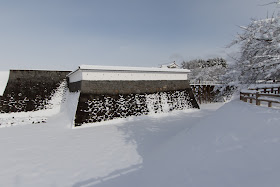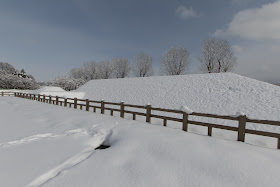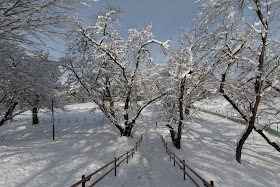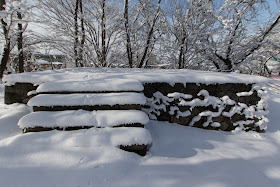Yamagata Castle
-Huge castle built by lord of struggle and misfortune-
Overview
Name: Yamagata castle (Yamagata-jo)
Alias: Kasumi-jo (Mist castle)
Place: Kajo-koen Yamagata city, Yamagata
Location: 38.25571854133395, 140.3270670205303
Type: Flat Castle
Built: Originally in 1357, expanded in 1590's
Remnants: Stone walls, clay walls and moats
Title: 100 famous Japanese castles
Yamagata castle (山形城) is located at the center of Yamagata city, the one places at the south half of Yamagata basin. Yamagata basin is a long and narrow basin spread along with Mogamigawa river, and a center of communication of southern half of Tohoku region connecting Sendai area (Miyagi prefecture), Shonai area (north western part of Yamagata prefecture), Yonezawa basin (southern part of Yamagata prefecture) and Akita area. Later in Edo era, as a posting town of Ushu Kaido, Yamagata area was an important area connected the Sea of Japan side of Tohoku region and Kanto area.
It is said that Yamagata castle was built by Kaneyori Mogami (1315-1379) in 1357. Kaneyori was originally born in Shiba clan, an distinguished house which was a branch family of Ashikaga clan, the founder of Muromachi Shogunate. At the beginning of Muromachi Shogunate, as anti Muromachi Shogunate power such as Emperor Godaigo supporter was strong in Tohoku region, Muromachi Shogunate appointed Iekane Shiba (1308-1356), father of Kaneyori, as Oshu Kanrei (general commander of Tohoku region) and sent to current Miyagi prefecture. Iekane further sent Kaneyori to current Yamagata basin, and Kaneyori defeated Samugae clan, the local lord and who was Emperor Godaigo supporter, and captured Yamagata basin.
Throughout Muromachi era Mogami clan gradually grew their power. Mogami clan placed their branch family all over the basin, and once prospered. But in the former half of 16th century, due to short live leader and internal conflicts, the power of Mogami clan significantly declined.
Tanemune Date (1488-1565), the leader of Date clan which was the warlord of Yonezawa basin and a great-grandfather of famous Masamune Date (1567-1636), attacked Yoshisada Mogami (1492-1520) and defeated at the battle of Hasedo castle. Mogami clan once subordinated to Date clan, and next leader Yoshimori Mogami (1521-1590) once became the puppet of Date clan.
However in 1542, a large internal conflict named “Tenbun no Ran” (incident of Tenbun) occured at Date clan between Tanemune and his son Harumune Date (1519-1577), and utilizing this opportunity Yoshimori left the effect of Date clan and became the independent warlord again. Yoshimori recovered Hasedo castle, and let his daughter princess Yoshihime (1547-1623) to Terumune Date (1544-1585), son of Harumune, and later Yoshhime became the mother of Masamune Date. Now Mogami clan could build stable base as a lord and started to expansion.
Yoshiaki Mogami (1546-1614), who was known as one of the leading peoples of Tohoku region, was the eldest son of Yoshimori. But Yoshimori hated Yoshiaki and planned to succeed his position to second son Yoshitoki Mogami, then an internal conflict between father and son occurred in 1570. At first Yoshimori was superior suppoted by Date clan, but Yoshiaki patiently fought with his father over four years and finally made peace by condition of leaving leader position to Yoshiaki.
Yoshiaki who became the leader of Mogami clan still faced many non obedient branch houses and local lords such as Kaminoyama clan, Tendo clan or Sagae clan. In addition to this, Date clan lead by Terumune Date, his brother in law, left the confusion after their internal conflict and started expansion again.
Facing this situation, Yoshiaki steadily beat each clan one by one, using every means from military attack to plots such as marriage head hunting or assassination. In 1578, Terumune Date assaulted Mogami clan in cooperation with Kaminoyama clan, and Yoshiaki was in the serious situation. But Yoshihime who was the younger sister of Yoshiaki and wife of Terumune placed her palanquin between both armies at the battlefield and let them make peace.
After the long and hard battle, Yoshiaki captured whole Yamagata basin by 1584. Further Yoshiaki suppressed Daihouji clan which governed Shonai area and also captured this area. But by this time, Masamune Date, the son between Terumune and Yoshihime who was called as “Single eye dragon”, rapidly grew his power. In 1588, when Masamune attacked Osaki clan, Yoshiaki sent a reinforcement army and defeated Date army together. Masamune fell into serious situation, but this time Yoshihime again placed her palanquin between both armies to save her son.
As a result, Masamune escaped this crisis and next year became the largest lord in Tohoku region beating Ashina clan. On the other hand, during Yoshiaki’s absence Kagekatsu Uesugi (1556-1623), the warlord of Echigo province (Niigata prefecture), invaded Shonai region and captured it. Broken hearted Yoshiaki subordinated to central ruler Hideyoshi Toyotomi (1537-1598) and the order of Tohoku region was once fixed.
As a large lord under Toyotomi government, Yoshiaki significantly expand Yamagata castle as a modern castle. Yoshiaki also improved castle town and road, then built the origin of current Yamagata city. But Yoshiaki had anthipathy with Hideyoshi, because his daughter Komahime was killed by Hideyoshi being involved the purge of Hideyoshi’s planned successor Hidetsugu Toyotomi (1568-1595), and also Toyotomi government supported Kagekatsu Uesugi for their invasion for Shonai region. After the death of Hideyoshi, Yoshiaki clearly supported Ieyasu Tokugawa (1543-1616), the largest lord under Toyotomi government, in contrast to Kagekatsu Uesugi who transferred to Aizu region and resisted to Ieyasu.
In 1600, Ieyasu marched toward Aizu region with other lords to subjugate Kagekatsu Uesugi, but utilizing this military vacuum Mitsunari Ishida (1560-1600), former chief administrative staff of Hideyoshi, raised his army to protect Toyotomi clan. Ieyasu returned his army to central region to make the decisive battle against Mitsunari, then Kagekatsu Uesugi who escaped military pressure of Ieyasu started his action to expand his territory.
As the territory and army of Mogami clan of only one fifth of Kagekatsu, thus Kagekatsu let his chancellor Kanetsugu Naoe (1560-1619) to conquer Mogami clan as quickly as possible. In September 1600, 30,000 soldiers of Uesugi clan started to invade to Yamagata basin from multiple road, and Hataya castle fell in only one day assaulted by overwhelming Uesugi army. At the same time, castles at the north part of Yamagata basin was captured by reinforcement of Uesugi army, and Yoshiaki faced his worst crisis.
But Kaminoyama castle which directly faced Uesugi territory well fought against Uesugi clan with small army. Further Hasedo castle, the final defense line of Yamagata castle and guarded by Mitsuyasu Shimura, stood the castle against Uesugi army of over 10 times. Kanetsugu made all out attack to Hasedo castle, but Mogami army rejected this attack and slayed Yasutsuna Kamiizumi, the general of Uesugi army. Further, Masamune Date who was the next target of Uesugi army unwillingly but sent their reinforcement to Mogami clan.
In September 29, Ieyasu Tokugawa made a decisive victory against Mitsunari Ishida at the battle of Sekigahara. Kanetsugu expected invasion of Ieyasu had to give up their invasion and retreat to their region. Yoshiaki fiercely chased Uesugi army but failed to catch Kanetsugu. But being evaluated his action, Ieyasu who became the next ruler gave Shonai region to Yoshiaki, and Mogami clan became one of the largest feudal lords of Edo Shogunate equivalent to Masamune Date. Yoshiaki further expanded Yamagata castle suitable for his territory.
The core part of Yamagata castle consist of three layer square shaped areas. The central area is about 200 meter length square had two combined gate at southeast edge and north side. Except for the side of each gate guarded by stone walls, the central area was
Protected by clay walls and water moat, and it had corner turret but main tower was not built.
Secondary area is a larger square of 500 meter length, surrounding the central area. The over all shape is the square but the wall is folded at here and there, to make a side attack to the enemy. There were two magnificent combined gate at south side and east side used as main gates, and also was a backside gate at north side.
The third area was about 2 kilometer length square outside of secondary area, and used as a residence of retainers. This area was not an outer barrier surrounding castle town but absolutely was a part of the castle. The size of original castle exceeded Sendai castle (Miyagi prefecture) or Aizu Wakamatsu castle (Fukushima prefecture) and was the largest castle in Tohoku region.
Type: Flat Castle
Built: Originally in 1357, expanded in 1590's
Remnants: Stone walls, clay walls and moats
Title: 100 famous Japanese castles
Brief History
Origin of Mogami clan and Yamagata castle
It is said that Yamagata castle was built by Kaneyori Mogami (1315-1379) in 1357. Kaneyori was originally born in Shiba clan, an distinguished house which was a branch family of Ashikaga clan, the founder of Muromachi Shogunate. At the beginning of Muromachi Shogunate, as anti Muromachi Shogunate power such as Emperor Godaigo supporter was strong in Tohoku region, Muromachi Shogunate appointed Iekane Shiba (1308-1356), father of Kaneyori, as Oshu Kanrei (general commander of Tohoku region) and sent to current Miyagi prefecture. Iekane further sent Kaneyori to current Yamagata basin, and Kaneyori defeated Samugae clan, the local lord and who was Emperor Godaigo supporter, and captured Yamagata basin.
Throughout Muromachi era Mogami clan gradually grew their power. Mogami clan placed their branch family all over the basin, and once prospered. But in the former half of 16th century, due to short live leader and internal conflicts, the power of Mogami clan significantly declined.
Tanemune Date (1488-1565), the leader of Date clan which was the warlord of Yonezawa basin and a great-grandfather of famous Masamune Date (1567-1636), attacked Yoshisada Mogami (1492-1520) and defeated at the battle of Hasedo castle. Mogami clan once subordinated to Date clan, and next leader Yoshimori Mogami (1521-1590) once became the puppet of Date clan.
However in 1542, a large internal conflict named “Tenbun no Ran” (incident of Tenbun) occured at Date clan between Tanemune and his son Harumune Date (1519-1577), and utilizing this opportunity Yoshimori left the effect of Date clan and became the independent warlord again. Yoshimori recovered Hasedo castle, and let his daughter princess Yoshihime (1547-1623) to Terumune Date (1544-1585), son of Harumune, and later Yoshhime became the mother of Masamune Date. Now Mogami clan could build stable base as a lord and started to expansion.
Hard fight to unite Dewa country
Yoshiaki Mogami (1546-1614), who was known as one of the leading peoples of Tohoku region, was the eldest son of Yoshimori. But Yoshimori hated Yoshiaki and planned to succeed his position to second son Yoshitoki Mogami, then an internal conflict between father and son occurred in 1570. At first Yoshimori was superior suppoted by Date clan, but Yoshiaki patiently fought with his father over four years and finally made peace by condition of leaving leader position to Yoshiaki.
Yoshiaki who became the leader of Mogami clan still faced many non obedient branch houses and local lords such as Kaminoyama clan, Tendo clan or Sagae clan. In addition to this, Date clan lead by Terumune Date, his brother in law, left the confusion after their internal conflict and started expansion again.
Facing this situation, Yoshiaki steadily beat each clan one by one, using every means from military attack to plots such as marriage head hunting or assassination. In 1578, Terumune Date assaulted Mogami clan in cooperation with Kaminoyama clan, and Yoshiaki was in the serious situation. But Yoshihime who was the younger sister of Yoshiaki and wife of Terumune placed her palanquin between both armies at the battlefield and let them make peace.
After the long and hard battle, Yoshiaki captured whole Yamagata basin by 1584. Further Yoshiaki suppressed Daihouji clan which governed Shonai area and also captured this area. But by this time, Masamune Date, the son between Terumune and Yoshihime who was called as “Single eye dragon”, rapidly grew his power. In 1588, when Masamune attacked Osaki clan, Yoshiaki sent a reinforcement army and defeated Date army together. Masamune fell into serious situation, but this time Yoshihime again placed her palanquin between both armies to save her son.
As a result, Masamune escaped this crisis and next year became the largest lord in Tohoku region beating Ashina clan. On the other hand, during Yoshiaki’s absence Kagekatsu Uesugi (1556-1623), the warlord of Echigo province (Niigata prefecture), invaded Shonai region and captured it. Broken hearted Yoshiaki subordinated to central ruler Hideyoshi Toyotomi (1537-1598) and the order of Tohoku region was once fixed.
Continuous struggle of Yoshiaki
As a large lord under Toyotomi government, Yoshiaki significantly expand Yamagata castle as a modern castle. Yoshiaki also improved castle town and road, then built the origin of current Yamagata city. But Yoshiaki had anthipathy with Hideyoshi, because his daughter Komahime was killed by Hideyoshi being involved the purge of Hideyoshi’s planned successor Hidetsugu Toyotomi (1568-1595), and also Toyotomi government supported Kagekatsu Uesugi for their invasion for Shonai region. After the death of Hideyoshi, Yoshiaki clearly supported Ieyasu Tokugawa (1543-1616), the largest lord under Toyotomi government, in contrast to Kagekatsu Uesugi who transferred to Aizu region and resisted to Ieyasu.
In 1600, Ieyasu marched toward Aizu region with other lords to subjugate Kagekatsu Uesugi, but utilizing this military vacuum Mitsunari Ishida (1560-1600), former chief administrative staff of Hideyoshi, raised his army to protect Toyotomi clan. Ieyasu returned his army to central region to make the decisive battle against Mitsunari, then Kagekatsu Uesugi who escaped military pressure of Ieyasu started his action to expand his territory.
Battle against Uesugi clan and victory
As the territory and army of Mogami clan of only one fifth of Kagekatsu, thus Kagekatsu let his chancellor Kanetsugu Naoe (1560-1619) to conquer Mogami clan as quickly as possible. In September 1600, 30,000 soldiers of Uesugi clan started to invade to Yamagata basin from multiple road, and Hataya castle fell in only one day assaulted by overwhelming Uesugi army. At the same time, castles at the north part of Yamagata basin was captured by reinforcement of Uesugi army, and Yoshiaki faced his worst crisis.
But Kaminoyama castle which directly faced Uesugi territory well fought against Uesugi clan with small army. Further Hasedo castle, the final defense line of Yamagata castle and guarded by Mitsuyasu Shimura, stood the castle against Uesugi army of over 10 times. Kanetsugu made all out attack to Hasedo castle, but Mogami army rejected this attack and slayed Yasutsuna Kamiizumi, the general of Uesugi army. Further, Masamune Date who was the next target of Uesugi army unwillingly but sent their reinforcement to Mogami clan.
In September 29, Ieyasu Tokugawa made a decisive victory against Mitsunari Ishida at the battle of Sekigahara. Kanetsugu expected invasion of Ieyasu had to give up their invasion and retreat to their region. Yoshiaki fiercely chased Uesugi army but failed to catch Kanetsugu. But being evaluated his action, Ieyasu who became the next ruler gave Shonai region to Yoshiaki, and Mogami clan became one of the largest feudal lords of Edo Shogunate equivalent to Masamune Date. Yoshiaki further expanded Yamagata castle suitable for his territory.
Structure of Yamagata castle
The core part of Yamagata castle consist of three layer square shaped areas. The central area is about 200 meter length square had two combined gate at southeast edge and north side. Except for the side of each gate guarded by stone walls, the central area was
Protected by clay walls and water moat, and it had corner turret but main tower was not built.
Secondary area is a larger square of 500 meter length, surrounding the central area. The over all shape is the square but the wall is folded at here and there, to make a side attack to the enemy. There were two magnificent combined gate at south side and east side used as main gates, and also was a backside gate at north side.
The third area was about 2 kilometer length square outside of secondary area, and used as a residence of retainers. This area was not an outer barrier surrounding castle town but absolutely was a part of the castle. The size of original castle exceeded Sendai castle (Miyagi prefecture) or Aizu Wakamatsu castle (Fukushima prefecture) and was the largest castle in Tohoku region.
Compared with these castles Yamagata castle was comparatively plain lacking magnificent stone walls and huge buildings, but due to the size of the castle and security of clay walls Yamagata castle had sufficient strength. This image of the castle matches to Yoshiaki himself, who was not eye catching but had the real ability.
But the struggle of Yoshiaki was not rewarded at last. Originally the retainers of Mogami clan were more independent compared with other clan, and the character of Yoshiaki barely gathered it. But after the death of Yoshiaki in 1614, there occurred an internal conflict between large retainers, and finally Mogami clan was extinguished due to improper management by Edo Shogunate in 1622.
After Mogami clan, Tadamasa Torii (1566-1629) became the lord of Yamagata castle. Tadamasa Torii was the son of Mototada Torii (1539-1600), a hereditary retainer of Ieyasu Tokugawa who guarded Fushimi castle (Kyoto prefecture) at the time of the battle of Sekigahara and died there.
Afterward of Mogami clan and Yamagata castle
But the struggle of Yoshiaki was not rewarded at last. Originally the retainers of Mogami clan were more independent compared with other clan, and the character of Yoshiaki barely gathered it. But after the death of Yoshiaki in 1614, there occurred an internal conflict between large retainers, and finally Mogami clan was extinguished due to improper management by Edo Shogunate in 1622.
After Mogami clan, Tadamasa Torii (1566-1629) became the lord of Yamagata castle. Tadamasa Torii was the son of Mototada Torii (1539-1600), a hereditary retainer of Ieyasu Tokugawa who guarded Fushimi castle (Kyoto prefecture) at the time of the battle of Sekigahara and died there.
Based on the his father achievement Tadamasa had comparatively large territory, and reformed Yamagata castle. Torii clan moved to Takato castle (Nagano prefecture) in 1636 and small hereditary retainers became lords of Yamagata castle, and as they could not maintain this huge castle, third area is abondoned by the end of Edo era.
Subsequent to Meiji revolution, all building of the castle was broken and the castle site became the base of Japanese army. Once walls and moats of central area was lost, but currently restoration of central area is gradually proceeding. Stone walls and clay walls of whole secondary area well remain, and buildings of East side front gate were reconstructed as a symbol of the castle. Plain but huge ruin of the castle slightly reminds us short glory of Yoshiaki Mogami after struggle.
15 minutes walk from JR East Ou Honsen / Yamagata Shinkansen line Yamagata station. 20 minutes drive from Yamagata Jidoshado Expressway Yamagata-Zao interchange.
Tsurugaoka Castle -Peaceful castle of domain of good governance-
Hataya Castle -Another campaign in Eastern Japan (1) swift attack-
Kanimoyama Castle -Another campaign in Eastern Japan (2) miscalculation-
Hasedo Castle -Another campaign in Eastern Japan (3) time's up-
Subsequent to Meiji revolution, all building of the castle was broken and the castle site became the base of Japanese army. Once walls and moats of central area was lost, but currently restoration of central area is gradually proceeding. Stone walls and clay walls of whole secondary area well remain, and buildings of East side front gate were reconstructed as a symbol of the castle. Plain but huge ruin of the castle slightly reminds us short glory of Yoshiaki Mogami after struggle.
Access
15 minutes walk from JR East Ou Honsen / Yamagata Shinkansen line Yamagata station. 20 minutes drive from Yamagata Jidoshado Expressway Yamagata-Zao interchange.
Related Castles
Tsurugaoka Castle -Peaceful castle of domain of good governance-
Hataya Castle -Another campaign in Eastern Japan (1) swift attack-
Kanimoyama Castle -Another campaign in Eastern Japan (2) miscalculation-
Hasedo Castle -Another campaign in Eastern Japan (3) time's up-





































































































































































No comments:
Post a Comment